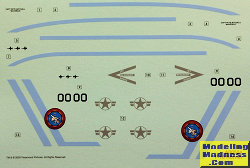
Airfix 1/72 F-18 'Top Gun'
| KIT #: | A00504 |
| PRICE: | $25.00 |
| DECALS: | One option |
| REVIEWER: | Spiros Pendedekas |
| NOTES: | Short run with etched and resin parts |

| HISTORY |
The McDonnell Douglas F/A-18 Hornet is an all-weather supersonic, twin-engine, carrier-capable, multirole combat aircraft. Designed by McDonnell Douglas and Northrop, the type was derived from the latter's YF-17 in the 1970s for use by the United States Navy and Marine Corps. The Hornet is also used by the air forces of several other nations, and formerly by the U.S. Navy's Flight Demonstration Squadron, the Blue Angels.
| THE KIT |
 This
is the 2020 reissue of the classic Airfix mold that was first introduced back in
1981 and has been reboxed another 15 times ever since. The kit is supposed to
represent Maverick’s F-18, as it appeared in the “Top Gun - Maverick” film,
which was initially scheduled to be released in summer 2019, but it was delayed
several times due to its complex action sequences and later the COVID-19
pandemic, to be finally released in 2022.
This
is the 2020 reissue of the classic Airfix mold that was first introduced back in
1981 and has been reboxed another 15 times ever since. The kit is supposed to
represent Maverick’s F-18, as it appeared in the “Top Gun - Maverick” film,
which was initially scheduled to be released in summer 2019, but it was delayed
several times due to its complex action sequences and later the COVID-19
pandemic, to be finally released in 2022.
The specific kit was bought from my hometown’s sole remaining little hobby shop as a gift to my 9yo son who performed well at school. It comes in a good quality medium sized top opening box, carrying an attractive box art of a Hornet carrying Maverick’s livery. As appealing as the box art can be, it is wrong, since Maverick’s F-18 in the Top Gun movie sequel was a Super Hornet. Moreover and, perhaps, more importantly, the kit itself contains the older Hornet with decals for the movie livery, meaning that the kit cannot represent the plane appearing in the movie.
Upon opening the box, I was greeted with 89 light blue gray styrene parts, neatly arranged in four equally sized sprues. General shapes of parts look correct to my inexperienced Hornet eye. Molding is on the soft side and there is an amount of flash at many parts that has to be cleaned off, together with a few ejector pin marks and a couple of sink marks. Panel lines are raised all over - more or less what one has to expect from an early 80s mold.
Cockpit is sparse, containing an instrument panel, stick and a quite good looking seat. An average looking pilot is provided and it might be a good idea to use him to blank the cockpit emptiness (or use a better looking one from your spares). The intakes and exhausts are shallow, while the landing gear is adequately represented, but the bays are totally flat. The speed brake is molded separately and can be posed “extended”. The elevators are positionable. Sufficient amount of external stores is provided, including three fuel tanks, four bombs, two Sidewinders and two Sparrows.
Transparencies are thick, but otherwise well molded and clear. Instructions come in the form of a three-folded leaflet, with the construction logically spread in 20 simple steps. Color callouts are provided at most, but not all areas, so some easy net research will help.
 Only one
scheme is provided, that of Maverick’s F-18, which, of course, is correct for a
Super Hornet and not for this one. Colors are given in Humbrol codes and in
generic form. Decals are superbly printed and, as with all "new Airfix" decals,
should work flawlessly.
Only one
scheme is provided, that of Maverick’s F-18, which, of course, is correct for a
Super Hornet and not for this one. Colors are given in Humbrol codes and in
generic form. Decals are superbly printed and, as with all "new Airfix" decals,
should work flawlessly.
Instructions want you to first assemble the cockpit and, together with the upper main bay wall and elevators, trap it between the upper and lower fuselage halves. The intakes and leading edge extensions are next (expect some fit issues there), followed by the wings, air brake and vertical stabilizers. The canopy is next, followed by the landing gear, the external stores and front finlets, ending a seemingly uncomplex build.
| CONCLUSIONS |
Though potent when introduced and still solid today, the Airfix 1/72 F/A-18 Hornet is a kit that, as of 2024, shows its age: while general shapes of parts look correct, molding is soft with an amount of flash, panel lines are raised (not a problem for a number of us, though) and details at key areas are average. While construction looks uncomplex, fit is expected to present some issues. Out of the box a good looking Hornet can emerge, albeit with some extra effort.
Be that as it may, the specific edition’s main issue is that it stands for a wrong livery, as Maverick flew a Super Hornet and not the older Hornet version in the Top Gun sequel. This is somehow a pity, as the decals are superbly printed. Kit price is also not that low, especially for such an old mold.
Having said that, there’s nothing wrong in getting that kit (especially if found at a discount) and even building it out of the box, representing a what-if scheme of Maverick’s plane before switching to the Super Hornet, or getting some aftermarket decals to depict a correct Hornet scheme.
Happy Modeling!
July 2024
Copyright ModelingMadness.com. All rights reserved. No reproduction in part or in whole without express permission.
If you would like your product reviewed fairly and fairly quickly, please contact the editor or see other details in the Note to Contributors.